.jpg)
.jpg)
Switchback Travel
.jpg)
.jpg)
Switchback Travel
You can’t overvalue a great pair of hiking socks: They keep your feet comfortable and dry while helping to prevent blisters and hotspots. We've tested the full array of styles in varied conditions, and below are our picks for the best hiking socks of 2024. Most of our favorites are made with merino wool, which has become the standard-bearer in socks and next-to-skin layers. It’s true that quality hiking socks are pricey—they generally run in the ballpark of $20-$25 per pair—but all of the options below are tough enough for trail duty and made to last. For more information, see our hiking sock comparison table and buying advice. And for more on hiking footwear, we’ve tested and written about the best hiking boots and best hiking shoes.
Editor’s note: We updated our hiking socks round-up on March 29, 2024, to move the Injinji Trail Midweight Mini-Crew up as the Best Hiking Socks for Blister Prevention. Given the time of year, we also removed the heavyweight Darn Tough Hiker Boot Full Cushion from our top picks.
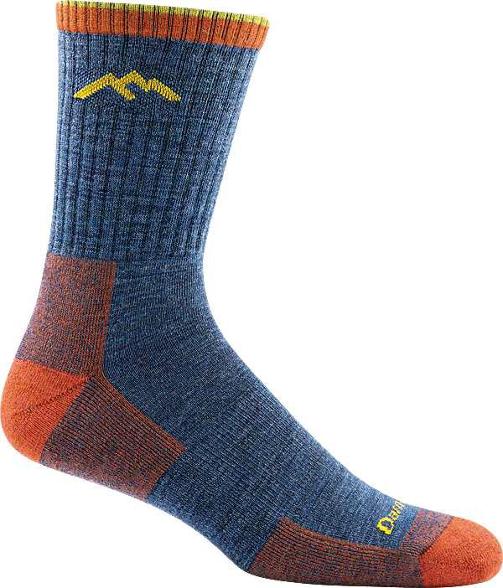 Materials: 61% merino wool, 36% nylon, 3% spandex
Materials: 61% merino wool, 36% nylon, 3% spandex
Cushioning: Light/medium
What we like: Comfortable and long-lasting; backed by Darn Tough’s lifetime guarantee.
What we don’t: Tough construction means they aren’t quite as plush as some other socks on this list.
Smartwool used to be synonymous with hiking socks, but over the past few years Darn Tough has taken the lead. With their cozy seamless construction, high-quality merino wool, and a lifetime warranty to back it up, Darn Tough socks simply are the best. Our favorite model for hiking and backpacking is the Hiker Micro Crew Cushion. High-density knitting creates excellent padding and breathability for virtually any 3-season outdoor activity. The fit is super comfortable, not overly elasticized around the arch or forefoot, and doesn’t bunch or create pressure points.
As we've found, no sock is totally perfect. Our nitpicks with the Hiker Micro Crew are that the cushioning underfoot can make the sock a little warmer on hot days than thinner models like the Smartwool Hike Light below, and the tough construction means losing a tiny bit of plushness. But this is telling: In all the miles we've racked up with our Hiker Micro Crews (some are 7+ years old and counting), we haven’t put a hole in one sock. And if you like Darn Tough socks but are looking for something a little more breathable, check out their Light Hiker Micro Crew model ($24), which is a thinner alternative with a performance fit similar to the Smartwool Hike Light below.
See the Men's Darn Tough Micro Crew See the Women's Darn Tough Micro Crew
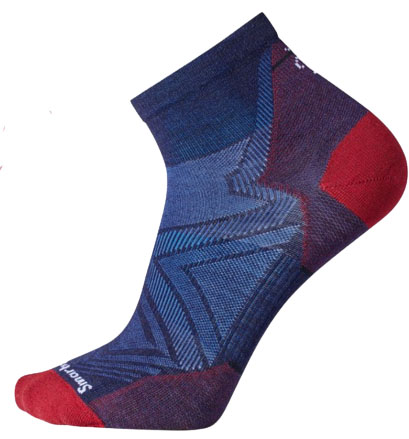 Materials: 46% merino wool, 51% nylon, 3% elastane
Materials: 46% merino wool, 51% nylon, 3% elastane
Cushioning: Ultralight
What we like: Light and breathable design is great for summer hiking.
What we don’t: Minimal cushioning impacts comfort as the miles add up.
For warm-weather hiking, trail running, and casual use with your sneakers, a minimally padded sock makes a lot of sense. And among the various ultralight options, Smartwool’s latest Run Zero Cushion Ankle Socks are our favorite. Competitively priced at $20, you get a great, snug fit, superb breathability, and a very comfortable feel. And as with the Hike Light Cushion Crew below, Smartwool added Indestructawool to these socks for a boost in durability. They still won’t last forever, but the Run Zero Cushion is a nice option for summer when you don’t need serious padding and thickness.
What are the downsides of choosing an ultralight hiking sock like the Smartwool? The materials are considerably thinner than the Darn Tough above, even in critical areas like the heel and toe box (although there is some reinforcement at the toes). But if you have tough feet and can avoid blisters, these socks will help keep your feet cool even during the hot summer months. And if you need some extra impact resistance, Smartwool does offer “targeted cushion" options within the same Run lineup, which add more padding around the heel and ball of the foot.
See the Men's Smartwool Run Zero Cushion See the Women's Smartwool Run Zero Cushion
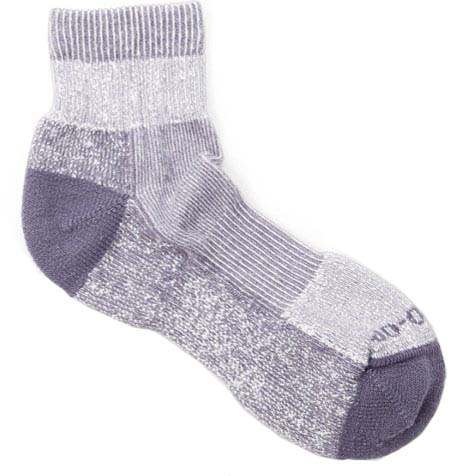 Materials: 77% Coolmax EcoMade, 22% nylon, 1% spandex
Materials: 77% Coolmax EcoMade, 22% nylon, 1% spandex
Cushioning: Light
What we like: Around $5-$10 cheaper than the merino competition.
What we don’t: Holds onto stink more than wool.
Not everyone is willing to spend $20+ on a pair of hiking socks, which we understand, and REI Co-op offers a budget-friendlier alternative to merino wool with their Coolmax EcoMade Lightweight Hiking Quarter. Made with fabric constructed from recycled plastic bottles, these socks provide a soft next-to-skin experience without the usual environmental burden of polyester (REI has been strong of late on the sustainability front). They wick moisture well too, making them a great choice for hot-weather adventures when you still want decent cushioning and support.
What do you sacrifice by saving with the REI Coolmax EcoMade? For starters, the synthetic material holds onto stink more than merino. And compared to Darn Tough’s Coolmax sock below, the REI generally fits a bit less snugly, especially over time (although they are the better value). In the end, if you’re anticipating a long-term investment for hiking and backpacking, it’s probably worth going the merino route. But the REI Coolmax excel for casual outings and light outdoor use, which is all many hikers need. Finally, this series also includes higher-riding crew socks, a thicker midweight option, and a couple “Flash” variations with targeted cushioning.
See the REI Coolmax EcoMade Lightweight
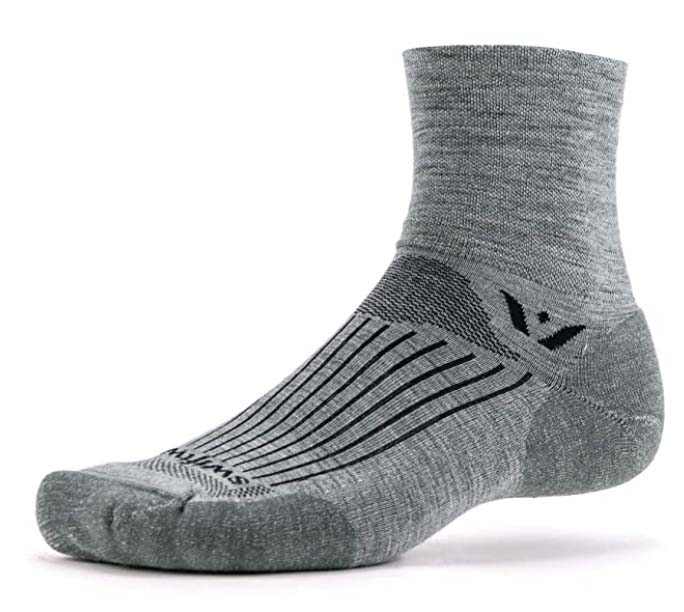 Materials: 63% merino wool, 35% nylon, 2% spandex
Materials: 63% merino wool, 35% nylon, 2% spandex
Cushioning: Light
What we like: Excellent fit, breathability, and cushioning for performance use.
What we don’t: Limited color options.
Technically billed as trail running socks, Swiftwick’s Pursuit Four is an excellent all-around performance pick. The socks were quick to win us over on ambitious outings and high-mileage days: The fit is snug and almost compression-like in feel, breathability is excellent even in warm summer temperatures, and you get a just-right amount of cushioning for high-impact activities like mountain biking, trail running, or hiking in trail runners (which generally have less protection underfoot than typical hiking shoes). Finally, we really like the height, which lands between a quarter-length design and traditional crew-cut models (we’d categorize it as close to a 3/4-length crew).
Importantly, Swiftwick lists the Pursuit Four as having medium cushioning, but we’ve found that it’s noticeably thinner and more breathable than options like the Darn Tough Hiker Micro Crew Cushion above and Balega Hidden Comfort below. Given its technical slant, the Pursuit Four also lacks some of the casual appeal and downright plushness of options like the Balega and REI picks above and below (we'd also prefer a few more color options). But for more technical pursuits that require your feet to work hard, you’d be hard-pressed to find a more well-rounded option, and it doesn’t hurt that the Pursuit Four is priced nicely at $20 (true compression models typically cost much more). For more hiking-focused alternatives from Swiftwick, their Flite XT Trail line includes features like grippy panels to prevent slippage and moisture-wicking Olefin fabrics.
See the Swiftwick Pursuit Four
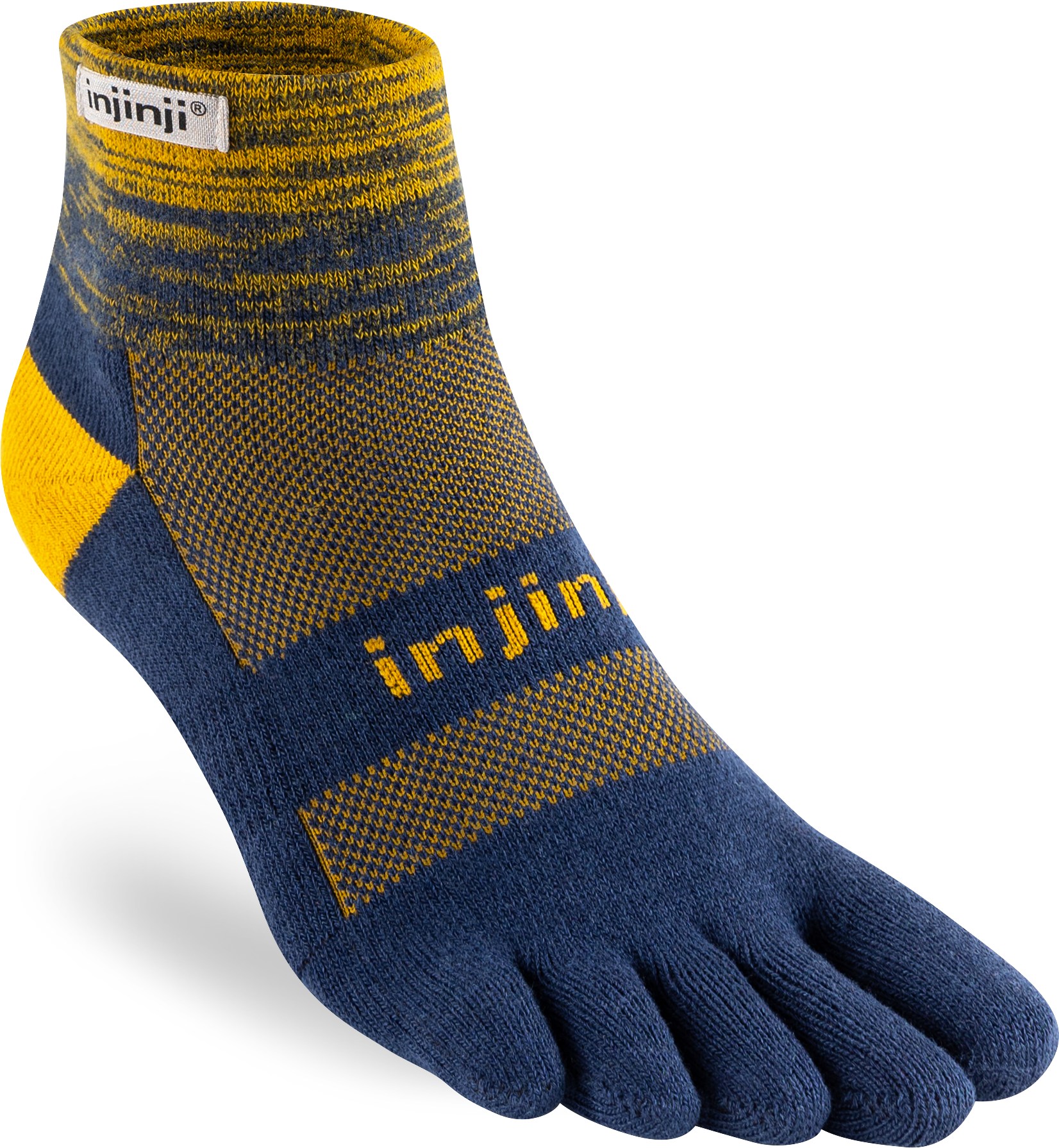 Materials: 58% nylon, 39% Coolmax, 3% Lycra
Materials: 58% nylon, 39% Coolmax, 3% Lycra
Cushioning: Medium
What we like: Five-toe design helps minimize hotspots and rubbing.
What we don’t: Takes much longer to put on than traditional socks; polarizing look and feel.
Right off the bat, we’ll note that Injinji socks are a far cry from the more traditional options above and below, and the polarizing looks will be enough to deter many hikers. But for those who struggle with blisters and other friction-related issues on the trail, there are some tangible performance benefits to the five-toe design. In use, we’ve suffered no discomfort even when breaking in new hiking shoes on intensive backpacking trips, and the separation (along with a mesh knit panel at the top of the foot) has left our toes dry after long and sunny days. The design is particularly appealing for long efforts—we’ve heard from many endurance athletes who love the socks’ blister-fighting abilities. A final bonus: They pair well with sandals that have toe loops, which is especially helpful for those who run cold but like the added security (this editor included).
All that said, there are some downsides to be aware of with the Injinji’s unique design. First and foremost is the added effort that it takes to put on these socks, as each toe needs to be worked into the appropriate slot. And it’s taken some time to get used to the feeling of having each toe separated in our hiking shoes, although the slight awkwardness did fade after a short time. In the end, here’s our take: If blisters and hotspots are a major issue for you, it may be worth giving the Injinji a shot. If not, traditional hiking socks perform great and require less work. Of note: Many Injinji loyalists also swear by their Liner Crew Socks, which can be worn underneath regular hiking socks or on their own (although the lack of padding means they’ll break down quickly without a protective layer overtop). For another blister-fighting option, Wrightsock’s Coolmesh II below uses a double-layer construction and has a much more conventional look.
See the Injinji Trail Midweight Mini-Crew
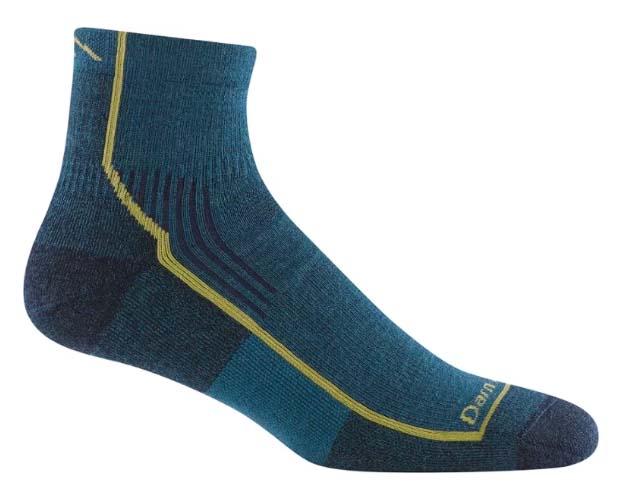 Materials: 61% merino wool, 37% nylon, 2% spandex
Materials: 61% merino wool, 37% nylon, 2% spandex
Cushioning: Light/medium
What we like: Cool, light, and very durable—a great match for long distances.
What we don’t: The lower cut means less protection.
Casual hikers may not care much about the construction of their socks, but thru-hikers covering long distances on trails like the AT or PCT prioritize an effective combination of breathability and durability. Enter Darn Tough’s Hiker Quarter Cushion, which is consistently one of the most popular and top-rated designs on the PCT. With these hiking socks, you get all of the comfort, moisture-wicking ability, and odor protection of crew-height socks, but in a trimmed-down form. It's true that they aren't tall enough for all hiking boots, but they're a great pairing with ankle-height hiking shoes or trail runners (and importantly, they offer considerably more coverage and protection than no-show designs like the Balega Hidden Comfort below).
Keep in mind that the Darn Tough Hiker Quarter Cushion aren’t true ultralight socks like the quarter-height Smartwool Run Zero Cushion above, meaning that your feet can get warm in the heat of summer and won’t dry out as quickly. But we appreciate the less bulky feel and added durability and heartily recommend these socks to anyone who doesn’t care for the higher cut but still wants the cushioning and coverage over the heel and ankle. There's a reason these socks are popular with high-mileage thru-hikers and serious backpackers: They get the job done.
See the Men's Darn Tough Quarter Cushion See the Women's Darn Tough Quarter Cushion
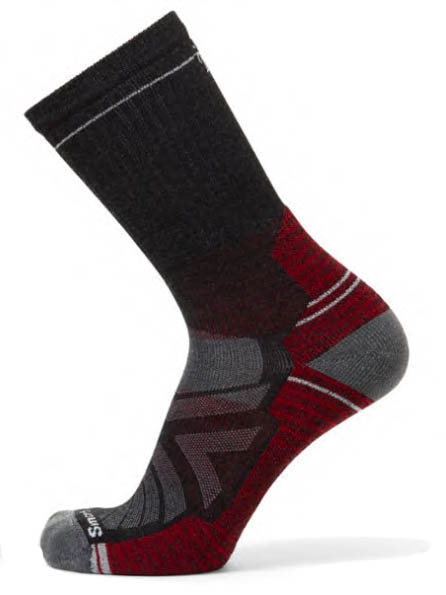 Materials: 56% merino wool, 42% nylon, 2% elastane
Materials: 56% merino wool, 42% nylon, 2% elastane
Cushioning: Light
What we like: Performance fit and now made with recycled materials.
What we don’t: Can't match Darn Tough's lifetime guarantee.
Smartwool overhauled their popular PhD collection a few seasons back with a number of notable tweaks to the design. Key changes include the use of sustainable materials (the Hike Light here uses 31% recycled nylon), increased cushioning (especially under the arch), and Smartwool also updated the mesh zones and overall fit. But most of the winning recipe remains largely the same, including sufficient padding under the heel and forefoot for trail running, hiking, and lightweight backpacking, as well as good breathability and a secure, foot-hugging shape. And we love the modernized designs and patterns, including mountainscapes and brighter colorways.
We’ve had durability issues with previous Smartwool models—particularly at the heel—but the brand now uses Indestructawool technology, which is a denser and tougher wool blend. The Hike Light has Indestructawool in the heel and toe, and we must say it has proven to be durable over the past few years without a noticeable change in comfort. Smartwool still can’t match Darn Tough's lifetime guarantee (although two years is pretty good), but we think the updates to the Hike collection are positive and give them a leg up in some areas, including fit and plushness.
See the Men's Smartwool Hike Light See the Women's Smartwool Hike Light
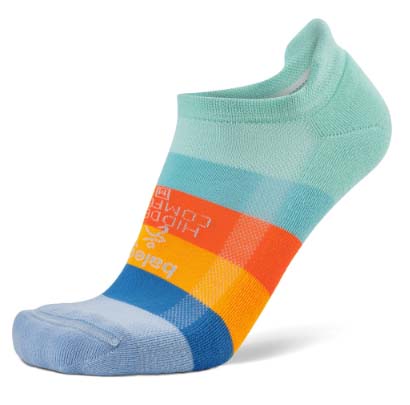 Materials: 32% Drynamix, 11% nylon, 3% neofil, 2% elastane
Materials: 32% Drynamix, 11% nylon, 3% neofil, 2% elastane
Cushioning: Medium
What we like: The most low-profile socks on our list and very comfortable.
What we don’t: Minimal coverage and no wool.
The crew and quarter-height socks above cover the heel and ankle, but no-show designs like the Balega Hidden Comfort ride even lower. Paired with a low-profile hiking shoe or trail runner (there isn’t enough clearance for ankle-height boots), the minimalist design offers sufficient cushion between your foot and shoe while minimizing bulk. Additionally, while many medium-cushioned socks run too warm during hot summer months, the Hidden Comfort’s synthetic Drynamix build wicks moisture and ventilates well (it also offers enough impact resistance for high-mileage days or while backpacking). All in all, these socks are highly comfortable, breathable, and stylish to boot.
As we mentioned, merino resists odor better than polyester, and no-show socks like the Hidden Comfort are more prone to letting dirt and grime sneak in through the top. Further, it’s important to ensure that the collar of your shoe falls below the top of the sock, as any gaps can cause uncomfortable rubbing. But for those who don’t mind the obvious sacrifices in protection and coverage, the Hidden Comfort is undeniably well made, good-looking, and super soft, which is a great combination for hiking (and did we mention no sock tans?). It’s worth noting that we had the brand’s Blister Resist ranked here previously, which adds in mohair to limit friction, although we haven’t experienced hot spots in either design. A final standout from Balega is their Silver No Show, which uses silver ions for fending off odors and bacteria, boasts compression-like arch support, and has a deep heel pocket to minimize slippage.
See the Balega Hidden Comfort
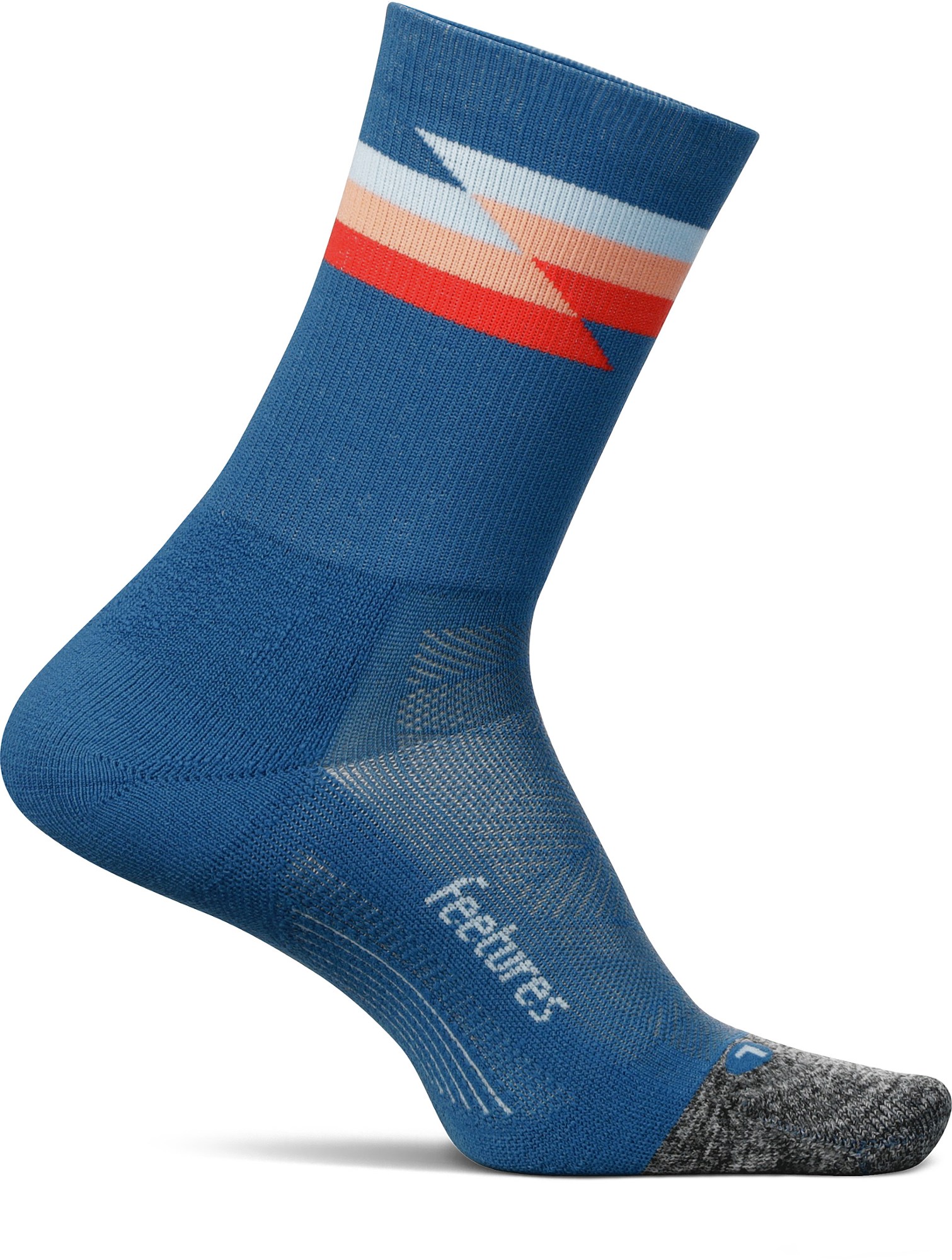 Materials: 94% nylon, 6% spandex
Materials: 94% nylon, 6% spandex
Cushioning: Light
What we like: Fantastic fit and feel, versatile height, and more durable than other Feetures socks we’ve tested.
What we don’t: Not adept at fighting odors; dedicated right and left socks require added attention when putting them on.
Smartwool and Darn Tough dominate the sock market, but upstarts like Feetures are hot on their heels—especially if styling is on your priority list. Their Elite Light Cushion Mini Crew was a quick favorite during testing. First and foremost, the socks have a fantastic feel thanks to the targeted compression zones—they’re not so tight that the on/off process is effortful like true compression socks, but the overall fit is snug and secure. We’re also big fans of the “mini crew” height, which offers more protection from scrapes and debris than quarter-height designs when wearing shorts. Importantly, we didn’t experience any bunching during testing, and the light padding offers a good balance between cushion and breathability. All in all, it’s the kind of sock that feels great to put on and fades into the background during activity.
It's important to note that the Feetures Elite Light Cushion Mini Crew forgo merino wool and instead use a mix of nylon and spandex. The blend is still soft and cozy, but we found that the socks collect stink far faster than merino alternatives. And while subjective, not everyone will like having dedicated left and right socks since it adds another step when putting them on. On the bright side, we’ve been impressed by the Elite Light Cushion’s durability thus far—a notable improvement over past experiences with quarter-height and no-show models from Feetures—and the design feels adequately tough for hiking and trail running. If you don’t mind a little extra washing and checking which sock goes on which foot each time, the Elite Light Cushion Socks have a whole lot going for them.
See the Elite Light Cushion Mini Crew
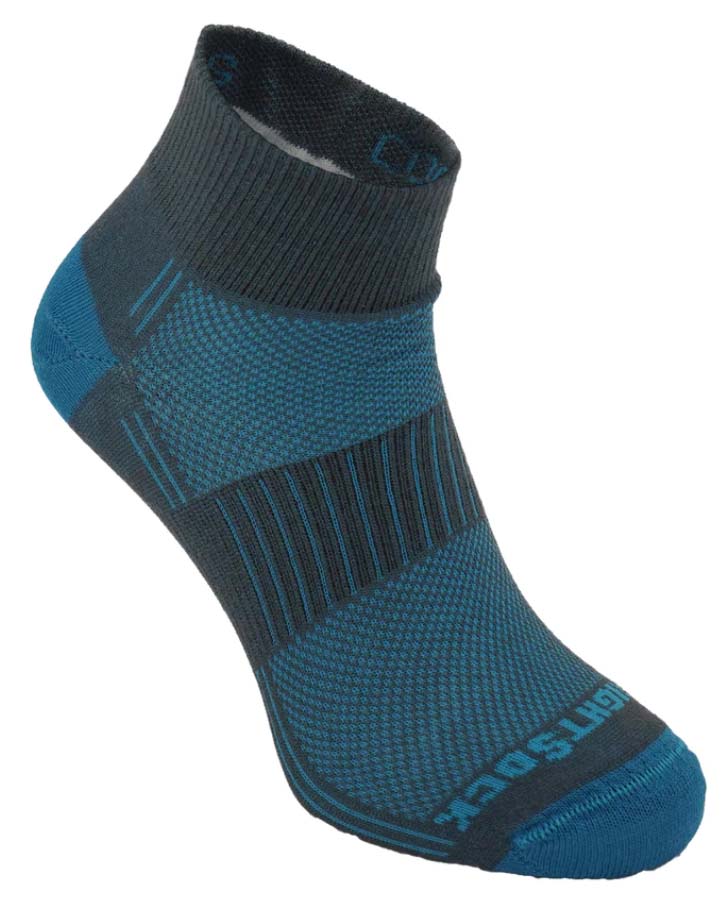 Materials: Inner layer: 70% polyester, 26% nylon, 4% Lycra; Outer layer: 71% polyester, 24% nylon, 5% Lycra
Materials: Inner layer: 70% polyester, 26% nylon, 4% Lycra; Outer layer: 71% polyester, 24% nylon, 5% Lycra
Cushioning: Light
What we like: Great protection from blisters and ultra-soft out of the box.
What we don’t: Not very cushioned and a little more tedious to put on than standard socks.
Injinji’s toe socks above are our top pick for blister-prone hikers, but Wrightsock takes a less polarizing approach with their Coolmesh collection. Made with a unique double-layer construction, the Coolmesh II works to absorb friction from your shoe or boot to limit potential trouble spots. The moisture-wicking inner layer keeps your feet dry, providing yet another barrier against blisters (one editor described the feeling as similar to wearing a skin-tight baselayer underneath a cozy midlayer). In fact, Wrightsock believes in their designs so much that they offer a “blister-free guarantee.” A refund won’t matter much if you’ve been suffering on the trail, but we do appreciate the confidence.
We recently brought the Wrightsock Coolmesh II on a backpacking trip in Washington State and came away highly impressed by the socks’ plush feel. They’ve lost some of their softness after multiple washes, but overall comfort remains excellent—and hard to beat at this price point. It’s true that they’re a little more tedious to put on (the inner layer occasionally catches on our toes), and the fairly minimal padding doesn’t inspire confidence from a long-term durability perspective. But if you want a light hiker for the summer months that will keep your feet cool and ward off hot spots and blisters, the Coolmesh has a lot of appeal. Wrightsock also makes the design in a crew version for $17 for those who prefer a little more coverage, as well as a no-show option for the same price as the quarter-height model here.
See the Wrightsock Coolmesh II Quarter
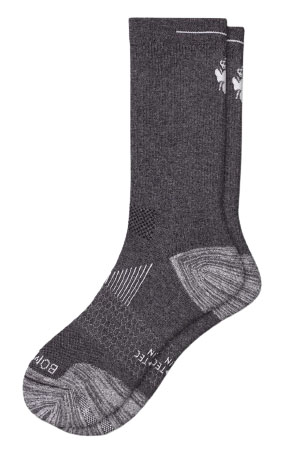 Materials: 58% polyester, 23% nylon, 14% cotton, 5% elastane
Materials: 58% polyester, 23% nylon, 14% cotton, 5% elastane
Cushioning: Lightweight
What we like: Remarkably comfortable and versatile; slightly more coverage than standard crew socks.
What we don’t: Prone to fraying; less of a performance fit than the Feetures above.
Running socks can cross over remarkably well for hiking—as evidenced by the Smartwool Run, Swiftwick Pursuit Four, and Feetures Elite above—and Bombas’ Running Calf Socks are another prime example. Starting with comfort, the synthetic/cotton blend is super soft and plush with a just-right amount of cushioning for long days on the trail (we categorize the socks as lightweight, but they’re edging on light/medium). We also love the sleek and performance-focused fit, which offers a healthy amount of stretch with enough elasticity at the cuffs to keep the socks in place. They’re not quite as snug as the Feetures above, which boast targeted compression, but the trade-off is a boost in everyday comfort. In fact, our running editor wears them just as much around the house as she does outdoors. And we’d be remiss not to mention the height, which is slightly taller than standard crew socks and great for pairing with joggers or 7/8 leggings while hiking or running.
What’s not to like with the Bombas Running Calf Socks? Long-term durability is our biggest concern: One tester experienced fraying after just one outing with the socks, although it was a fairly technical traverse over rocky terrain. The Bombas will also require fairly frequent washing to fend off stink, but that’s true of any synthetic design. And like the Feetures above, there are dedicated left and right socks for a more ergonomic fit, although we haven’t noticed a marked difference when accidentally wearing them on the wrong foot. Again, the Running Calf Socks aren’t the most durable option available, but the advantages in comfort and fit certainly help offset the downsides.
See the Men's Bombas Running Calf Socks See the Women's Bombas Running Calf Socks
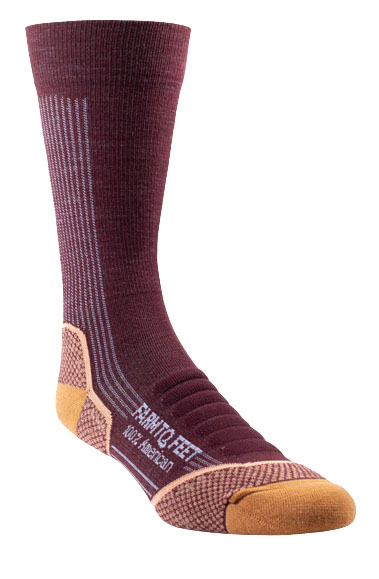 Materials: 51% merino wool, 46% nylon, 3% Lycra
Materials: 51% merino wool, 46% nylon, 3% Lycra
Cushioning: Light
What we like: High-quality design that is sourced and made in the U.S.
What we don’t: Less merino and pricier than the Smartwool Hike Light above.
Designed with thru-hikers in mind, Farm to Feet’s Damascus Light Targeted Cushion offers a nice blend of breathability and cushioning for long days on the trail. With a seamless toe area for minimizing bulk and preventing blisters, strategic padding in high-wear areas, and a snug performance fit, the Damascus is purpose-built to handle trail life. Further, all Farm to Feet socks are backed by the company’s generous lifetime guarantee that rivals Darn Tough’s well-known warranty. But what sets Farm to Feet apart is that their products are 100% sourced and made in the United States, including American-raised sheep providing the merino wool.
The Damascus’ closest competitor on this list is the Smartwool Hike Light Cushion Crew above, which boasts slightly more merino (56%) at $1 less per pair. However, the Farm to Feet is no slouch. Specifically, we like the sock’s thick panels of padding over the forefoot, which reduce friction between your foot and boot to keep you comfortable on longer objectives. Another draw is Farm to Feet’s superior warranty (Smartwool’s is only two years), which could be a deciding factor for those who put in a lot of miles. The Damascus lineup also includes 3/4-length crew, quarter-height, and full-cushion socks that share similar overall designs and features.
See the Damascus Light Targeted Cushion
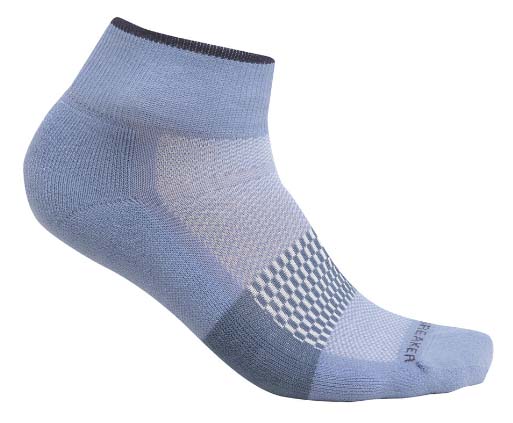 Materials: 63% merino wool, 35% nylon, 2% Lycra
Materials: 63% merino wool, 35% nylon, 2% Lycra
Cushioning: Light
What we like: More merino than the Smartwool Run Zero Cushion above.
What we don’t: Slightly thicker and less breathable.
For those unfamiliar, Icebreaker is a merino specialist based out of New Zealand that sources all of their wool from local farms in the region’s Southern Alps. They’re well known for their focus on sustainability and environmentally friendly production practices, and we’ve had positive experiences with everything from their baselayers to their socks. The Merino Multisport Light Mini Socks here are a nice reflection of the brand’s high attention to detail: They’re well built with a healthy dose of merino (63%) and nylon/Lycra mixed in for added durability and stretch, a seamless toe for minimizing blisters and hot spots, and a thinner construction at the top of the foot for added ventilation. Icebreaker also focused the elasticity at the heel and instep to maximize stability, and the socks have a snug, performance-ready fit that holds its shape over time.
The Icebreaker Merino Multisport Light Mini Socks go head-to-head with Smartwool’s Run Zero Cushion Ankle Socks above as a lightweight pick for summer adventures. In parsing out the differences, the Multisport has 17% more wool for a nice boost in comfort and odor prevention and costs $1 less per pair. However, the Run Zero Cushion is noticeably thinner and more breathable, making it the better match for higher-output activities like trail running in the heart of summer (Icebreaker does sell ultralight “Run+” versions that contain between 45 and 51% merino). But the minimal padding won’t work for everyone, and those with finicky or blister-prone feet will likely prefer the more cushioned and forgiving feel of the Multisport. If you prefer an even lower cut for pairing with sneakers, it’s also sold in a no-show Micro version for the same price.
See the Icebreaker Merino Multisport Light Mini See the Women's Merino Multisport Light Mini
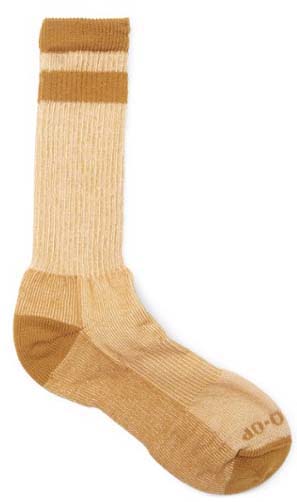 Materials: 79% merino wool, 20% nylon, 1% spandex
Materials: 79% merino wool, 20% nylon, 1% spandex
Cushioning: Light
What we like: Great value, soft feel, and certified to the Responsible Wool Standard.
What we don’t: Design is a bit dated and prone to pilling.
If you’re sold on the benefits of merino but are looking to save, the REI Merino Wool Lightweight Hiking Crew socks are just the ticket. For a reasonable $18, you get the comfort and temperature regulation one expects from merino (and a whole lot of it at 79%) with few compromises. These socks are soft, wick moisture well, and offer sufficient padding for most moderate hiking and backpacking with added reinforcements in friction-prone areas like the heel, toe, and footbed. And REI recently tacked on an RWS (Responsible Wool Standard) certification, which ensures that sheep were treated humanely during production.
The REI Merino Wool Lightweight Hiking Crew socks are an undeniable value, undercutting similarly built alternatives like the Darn Tough Hiker Micro Crew Cushion and Smartwool Hike Light above by $4-$5 per pair. That said, overall performance does fall short: We’ve noticed that the socks are prone to pilling on the upper portion, and both the Darn Tough and Smartwool tend to hold their shape better over time due to their denser weaves. The REI socks also lack the crossover appeal of many of the more modern options above, and the design is a bit of a throwback with drab colorways and a looser (rather than performance-focused) fit. But again, you’d be hard-pressed to find more merino for less, making REI’s Merino Wool collection an excellent value for most casual outdoor-goers. For added warmth and cushioning, REI sells midweight ($20) and winter-ready Expedition ($23) variations that are priced aggressively, too.
See the REI Merino Wool Lightweight Hiking Crew
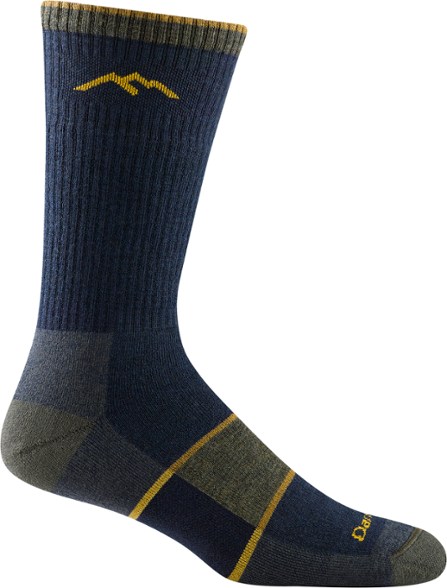 Materials: 66% merino wool, 32% nylon, 2% Lyrcra
Materials: 66% merino wool, 32% nylon, 2% Lyrcra
Cushioning: Heavy
What we like: Darn Tough quality and toughness in a very warm and cozy build.
What we don’t: Limited appeal for most summer and shoulder-season adventures.
The top-ranked Darn Tough Hiker Micro Crew Cushion socks are a great option for moderate temperatures and even into the shoulder seasons, but for true mountain-ready performance, we turn to their beefier Hiker Boot Full Cushion. Stacked up against the Hiker Micro Crew, the model here boasts thicker cushioning with more merino (66% vs. 61% for the Micro Crew), giving it a nice boost in coziness and insulation for activities like summertime mountaineering and winter hiking and snowshoeing. We also love the performance fit, which provides a secure, snug feel that stays in place and doesn’t feel overly bulky. All told, these socks are well built, impressively durable, and highly comfortable for long days in frigid temps.
As with all heavyweight socks, you’ll want to take your boots into consideration before buying to ensure you have enough room. That said, the Hiker Boot Full Cushion does have a noticeably lower-profile and less cumbersome feel than Smartwool’s popular Classic Hike Extra Cushion (not included here), which one editor accurately described as slipper-like. The Smartwool does get the edge in price at $24, but it contains less merino (56%), and we prefer the tighter and more streamlined fit of the Darn Toughs for maximizing performance while minimizing bulk. Both socks run too warm for most sub-alpine summer outings, but if your itinerary includes logging considerable mileage in the cold or above treeline, the Hiker Boot Full Cushion is a proven option that should last many seasons. And for the ultimate in warmth for hut trips or long days working in frigid weather, check out Smartwool’s ultra-thick and plush Classic Mountaineer.
See the Men's Darn Tough Hiker Full Cushion See the Women's Hiker Boot Full Cushion
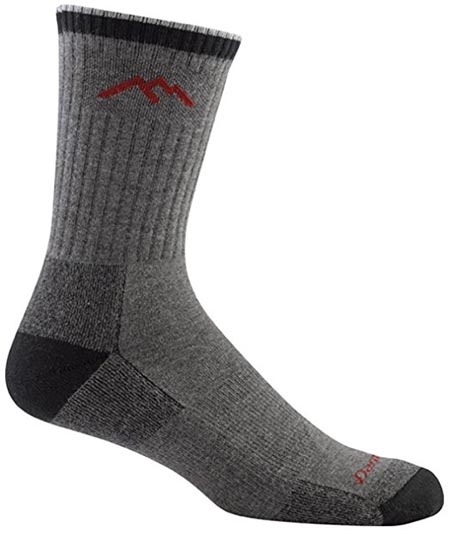 Materials: 37% nylon, 34% Coolmax, 26% acrylic, 2% Lycra, 1% other
Materials: 37% nylon, 34% Coolmax, 26% acrylic, 2% Lycra, 1% other
Cushioning: Light/medium
What we like: A high-performance synthetic sock.
What we don’t: We still prefer merino over Coolmax.
On particularly hot summer days, you just might not want to put wool on your feet, which is understandable. For these occasions, Darn Tough makes a synthetic sock with Coolmax polyester (the same material used in the budget REI option above), a highly porous fabric that is made specifically to keep your feet cool. These socks are a nice option for hot-weather hikers, and like our favorite merino models, they are snug-fitting, well cushioned, and do not stretch with use. All that, and the bump in breathability is noticeable.
Compared to REI’s Coolmax sock above, Darn Tough’s version is better-made and offers a much closer fit (the downside is a jump in price). In fact, it’s one of the only non-merino socks that you’ll find us recommending for serious performance use. Unfortunately, Coolmax socks undeniably hold stink far more than merino models, which is a big downside for multi-day backpacking trips. Unless you’re specifically looking for an alternative from wool or hiking in the warmest of temperatures, we still deem merino to be superior in almost every way.
See the Men's Darn Tough Coolmax See the Women's Darn Tough Coolmax
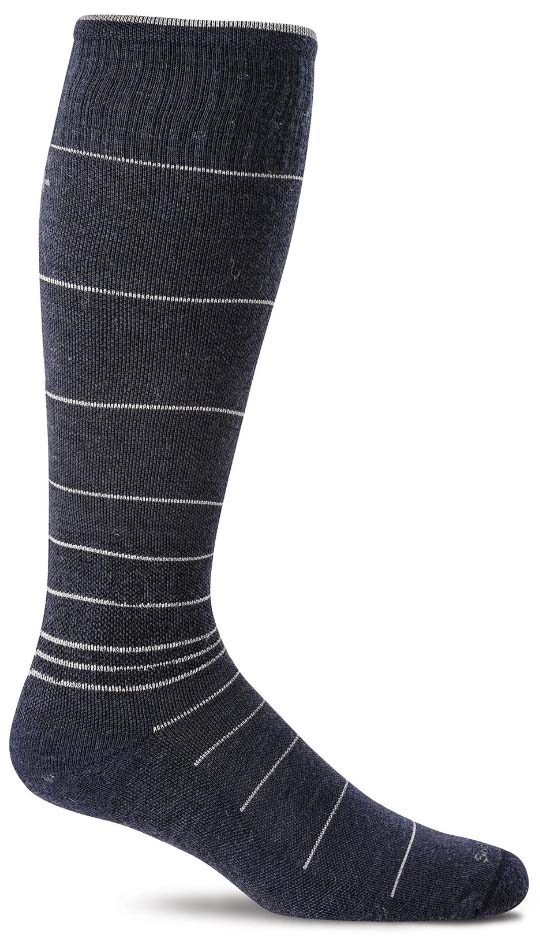 Materials: 32% merino wool, 32% stretch nylon, 31% rayon, 5% spandex
Materials: 32% merino wool, 32% stretch nylon, 31% rayon, 5% spandex
Cushioning: Light
What we like: Very snug and secure fit.
What we don’t: Knee-high design isn’t for everyone; fairly pricey for the amount of wool.
For long-distance trekking, peak-bagging, and other mileage-heavy pursuits, some hikers and backpackers now turn to compression socks to improve blood flow and help with overall support. The jury is still out on the true efficacy of compression technology, but we’ve found that the added snugness does help with minimizing fatigue over long distances (it’s also a plus for those who suffer from chronically cold feet). In this category, Sockwell’s Circulator is a great pick for those looking for a supportive, calf-hugging design that adds an extra dose of security on the trail.
At $30 and with very little merino in the build, the Sockwell Circulator is fairly pricey for the mix of materials you get. Further, the Circulator comes up to just below the knees, which helps with coverage and protection when venturing off-trail but isn’t everyone’s cup of tea. If you prefer a lower cut, Sockwell’s Modern Mountain Compression Crew Socks boast 41% merino but are thicker and less breathable than the Circulator. Finally, compression socks in general are more popular among the ski and road cycling communities (where the tech has more of a potential impact on recovery), but some hikers find the boosts in security and added performance worth the slight cost penalty. If you’re regularly putting in the miles and want to try something a little different, give the Sockwell Circulator a look.
See the Men's Sockwell Circulator Socks See the Women's Sockwell Circulator Socks
| Sock | Price | Materials | Cushion | Height |
|---|---|---|---|---|
| Darn Tough Hiker Micro Crew | $25 | 61% merino, 36% nylon, 3% spandex | Light/medium | Crew |
| Smartwool Run Zero Cushion | $20 | 46% merino wool, 51% nylon, 3% elastane | Ultralight | Quarter |
| REI Coolmax EcoMade Lightweight | $16 | 77% Coolmax EcoMade, 22% nylon, 1% spandex | Light | Quarter |
| Swiftwick Pursuit Four | $20 | 63% merino wool, 35% nylon, 2% spandex | Light | 3/4 crew |
| Injinji Trail Midweight Mini-Crew | $16 | 58% nylon, 39% Coolmax, 3% Lycra | Medium | Quarter |
| Darn Tough Hiker Quarter Cushion | $22 | 61% merino, 37% nylon, 2% spandex | Light/medium | Quarter |
| Smartwool Hike Light Cushion Crew | $24 | 56% merino, 42% nylon, 2% elastane | Light | Crew |
| Balega Hidden Comfort | $16 | 32% Drynamix, 11% nylon, 3% neofil, 2% elastane | Medium | No-show |
| Feetures Elite Light Mini Crew | $20 | 94% nylon, 6% spandex | Light | 3/4 crew |
| Wrightsock Coolmesh II Quarter | $15 | Inner: 70% polyester, 26% nylon, 4% Lycra; Outer: 71% polyester, 24% nylon, 5% Lycra | Light | Quarter |
| Bombas Running Calf Socks | $18 | 58% polyester, 23% nylon, 14% cotton, 5% elastane | Light | Crew |
| Farm to Feet Damascus Light | $25 | 51% merino wool, 46% nylon, 3% Lycra | Light | Crew |
| Icebreaker Multisport Light Mini | $19 | 63% merino wool, 35% nylon, 2% Lycra | Light | Quarter |
| REI Merino Lightweight Crew | $18 | 79% merino wool, 20% nylon, 1% spandex | Light | Crew |
| Darn Tough Hiker Full-Cushion | $28 | 66% merino wool, 32% nylon, 2% Lyrcra | Heavy | Crew |
| Darn Tough Coolmax Micro Crew | $24 | 37% nylon, 34% Coolmax, 26% acrylic, 2% Lycra, 1% other | Light/medium | Crew |
| Sockwell Circulator Compression | $30 | 32% merino wool, 32% stretch nylon, 31% rayon, 5% spandex | Light | Calf |
As avid hikers and backpackers, the Switchback Travel team has tested hundreds of hiking socks. Former editor-in-chief John Ellings originally compiled this guide in 2015 with just six picks. Over the years, he and managing editor Sarah Nelson, who began contributing to the round-up in 2021, continued expanding the picks through regular on-trail testing. An avid trail runner and mountain biker, John has worn—and worn through—dozens of socks, from longstanding classics from Darn Tough and Smartwool to vibrant designs from upstarts like Feetures and Balega. Sarah is similarly well versed in the hiking sock world, with a (constantly growing) drawer full of options for trail running, hiking, backpacking, and general outdoor use.
The current list of 17 picks above is the result of our aforementioned testing, along with feedback from fellow staff members, contributors, and the online hiking community. When we test hiking socks, we wear them on our daily adventures—both close to home and deep in the backcountry—and make note of how thick they are, how high they ride on our ankles or calves, how well they hold their shape throughout the day and over time, and how frequently they require washing. We also pay attention to all day-comfort and long-term durability, looking for pills and other signs of wear throughout testing. As new socks hit the market and we continue exploring various designs and brands, we’ll be sure to add any standouts to the list above.
.jpg)
Merino Wool
Years ago, you might have seen a smattering of cotton and polyester hiking socks on the trails, but merino wool is now the leader far and away. Merino—the namesake wool from a highly prized type of sheep that lives predominantly in harsh mountain environments, including New Zealand’s Southern Alps—is extremely comfortable, wicks moisture well, and does a nice job of breathing and regulating temperature. It also takes much longer to build up stink, allowing for extra days of wear on a hiking or backpacking trip (how many days is up to you). Cotton, on the other hand, is heavier, absorbs moisture, and doesn't dry when wet. And while polyester may keep you cool, we are yet to find an option that doesn't start stinking rather quickly.
.jpg)
That said, it’s important to note that even merino wool hiking socks aren’t 100% merino: You’ll notice in our picks above that the percentage of merino is between around 30 and 80%, with the rest being a blend of nylon and spandex. The density varies by sock as well—just because the REI Merino Wool Lightweight Hiking Crew socks are 79% merino doesn’t mean they are the highest-quality option. Darn Tough's Hiker Micro Crew Cushion socks, for example, are around 61% merino but the weave is denser, and they tend to hold their shape better and last longer.
.jpg)
Polyester
In general, we strongly prefer merino wool over polyester. Merino is known for its natural antimicrobial properties, whereas polyester socks hold stink in a serious way (this alone has us firmly in the merino camp). Moreover, merino wool is a naturally sourced material, whereas polyester is made from plastic fibers.
That said, polyester does have a couple of redeeming qualities. For one, it is highly durable, lasting longer than pure merino. In addition, it does not soak up water to the extent that merino does, allowing it to dry faster. And some of the Coolmax models like the Darn Tough Coolmax Micro Crew provide excellent breathability for adventuring in hot conditions. Finally, for those looking for synthetic material that is kind to the environment, check out Coolmax EcoMade (seen in the REI Co-op Coolmax EcoMade Lightweight), a polyester made from recycled plastic bottles.
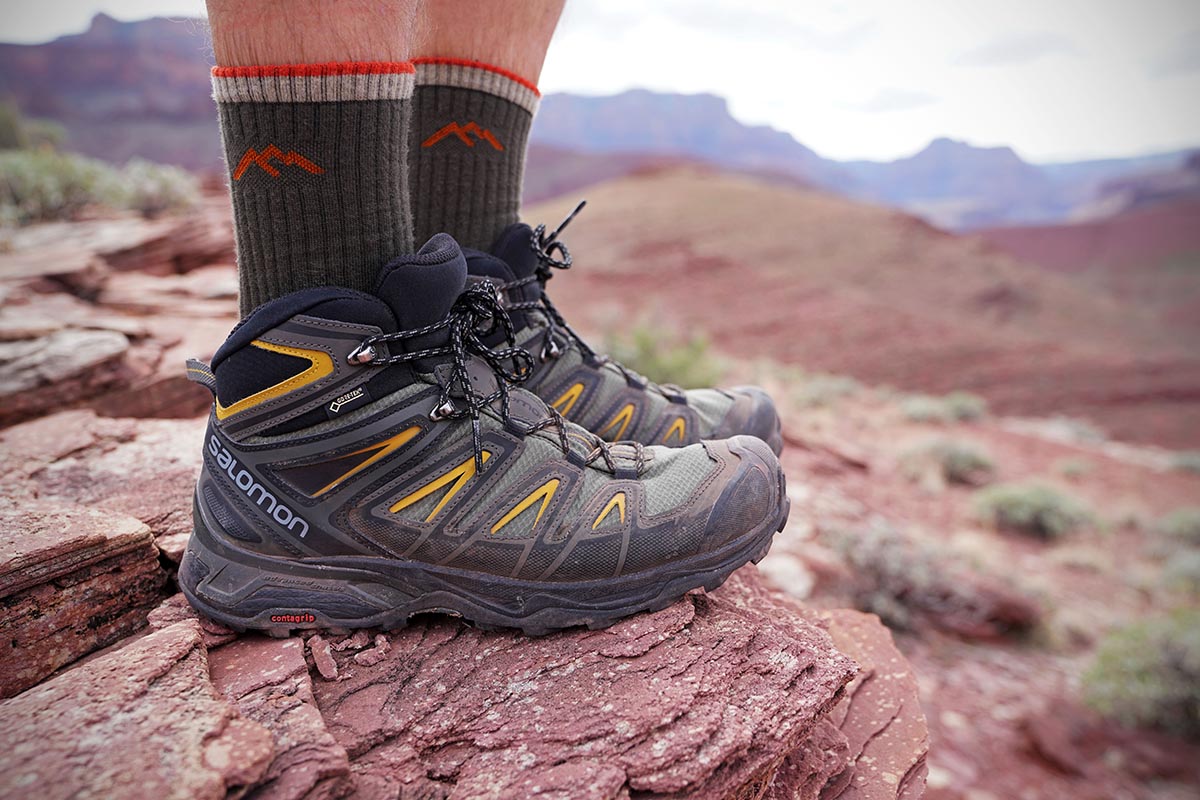
Sock manufactures offer a variety of thicknesses designed for everything from summer hiking to mountaineering. For the purposes of this section, we are evaluating overall sock thickness (ultralight, lightweight, midweight, etc.) and not the strands themselves as described above. For 3-season hiking, backpacking, and casual wear, we recommend the lightweight versions, which provide solid levels of padding and insulation for temperatures from approximately 40 degrees to 80 degrees Fahrenheit. They also wear well around the house and under your favorite pair of shoes, provided there’s enough room.
.jpg)
If you’re hiking in hot places like Utah or Arizona in low-top hiking shoes, you may want to consider an ultralight hiking sock. The downside is that ultralight socks are thin on the foot and offer significantly less padding and blister protection than lightweight and midweight socks. Another option for summer hikers is a lightweight hiking sock in a 1/4 height, which has less leg coverage and a more airy feeling but the same cushion on the foot. For winter hiking and mountaineering, the major brands make midweight and heavyweight options that provide much more warmth than the lightweight versions, like Darn Tough's heavyweight Hiker Boot Full Cushion above and Smartwool’s Classic Hike Extra Cushion Crew (not included here). Keep in mind that these burly socks are overkill for 3-season hiking and casual use. In normal temperatures your feet will sweat, and despite merino’s impressive ability to wick moisture, you will get unwanted dampness.
.jpg)
Crew Socks
Crew is the most common hiking sock height, which extends 6 to 8 inches above the heel and at a least a couple of inches above just about any pair of hiking boots. We feel that this is the optimal height for hiking: Crew socks don’t make you excessively hot and offer some added lower leg protection from brush and rocks. Hiking pants can be quite thin, so the extra cushion is helpful, and particularly if you’re wearing shorts on all but the easiest of trails, crew is the way to go.
.jpg)
Quarter Socks
Quarter (1/4) height hiking socks cover the heel and ankle but don’t extend up the leg as far as crew socks. Minimalist hikers and those out in the heat of summer may prefer 1/4 socks like the Darn Tough Hiker Quarter Cushion, which work well so long as you aren’t wearing boots with high ankles (you may end up feeling some friction) and don’t need protection from abrasions. This style also crosses over well to wear with running shoes.
.jpg)
No-Show Socks
Even lower than quarter-length are no-show socks. If you’re wearing low-riding hiking or trail-running shoes, a no-show sock should rise just above the collar and still offer padding and protection between your ankle and shoe. However, keep in mind that no-show socks have a greater chance of letting in trail debris like gravel or dirt, and a poor fit could lead to rubbing along your heel and ankles. We prefer 1/4 socks for most of our outdoor endeavors simply for the added coverage, but shorter socks, like Balega’s Hidden Comfort, are undoubtedly lower-profile and have appeal for those looking to minimize bulk.
.jpg)
Over-the-Calf Socks
As their name implies, over-the-calf socks rise higher than crew socks to just below the knee. By covering more of your leg, they can be a great option for hiking off-trail through high grass or brush, or in cases where you need extra warmth. On our list above, Sockwell’s Circulator Compression Socks fall just below the knee and add a boost in security around the calf, which some find helpful for muscle recovery and maximizing circulation. However, in most scenarios, crew socks should provide ample coverage and protection.
.jpg)
Compression is a bit of a buzz word among outdoor athletes these days, praised for its ability to help with muscle recovery and reduce overall fatigue. In the hiking realm, some trekkers find compression socks helpful when covering long distances or traveling in cold weather, as the added support can help alleviate soreness and encourage blood flow. We included one compression model on our list above—the Sockwell Circulator—which is a nice match for those who want a bit of added snugness and security on the trail. You can expect to pay a bit more for dedicated compression models—and they’re certainly not for everyone—but some may find the potential benefits worth the investment.
After countless miles on the trail, our observations on hiking sock comfort are as follows: Darn Tough makes the best overall hiking socks taking into account comfort and durability, but they have a slightly thicker and denser feel than Smartwool. This isn’t a bad thing—Darn Tough socks can really take a beating (hence the name). Smartwool hiking socks have great breathability and an excellent fit, particularly the Hike line, but over the years, we’ve had more issues with durability and holes. There also are a handful of up-and-comers like Feetures that are a slight step down in overall comfort but have more attractive styling that many hikers appreciate. Last but not least, brands like REI aim for more value-oriented buyers, and the snugness and durability can’t match Darn Tough and Smartwool.
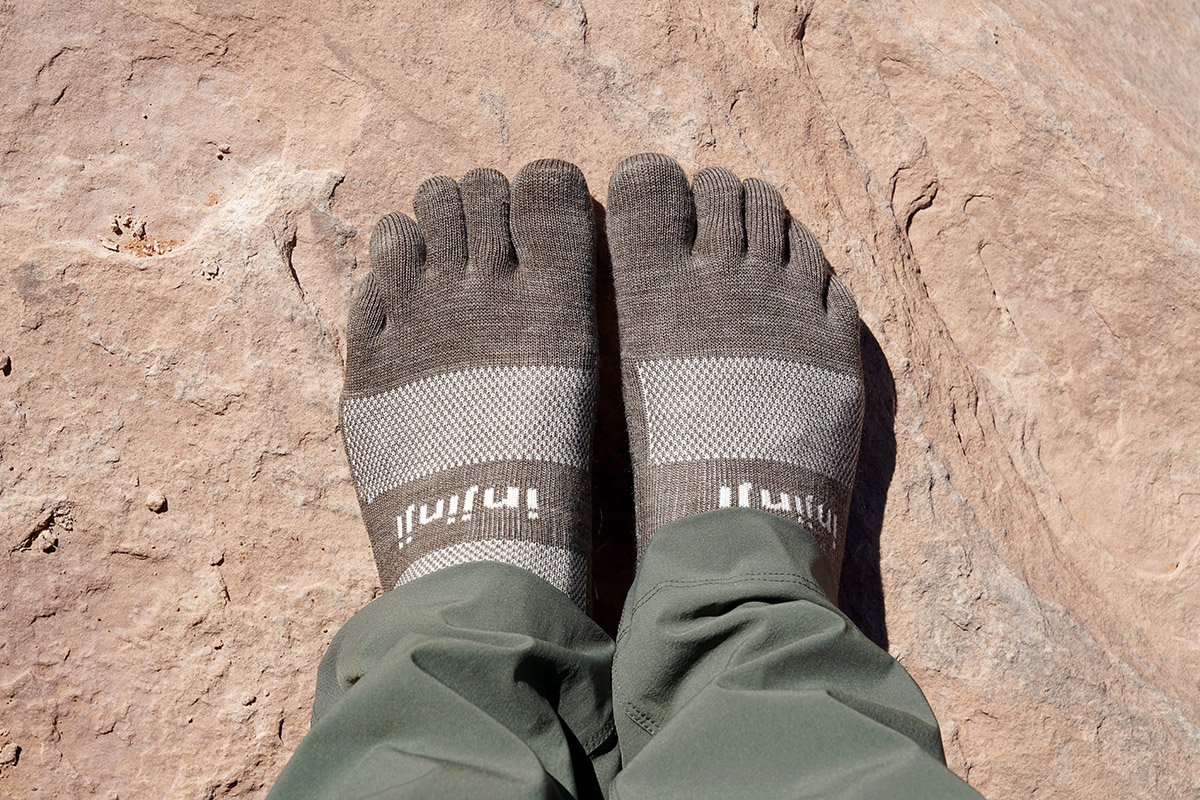
It’s incredible how many times we’ve put our hiking socks through the washer and dryer and had them come out feeling and fitting like new. Durability is brand specific and we’ve seen changes throughout the years even among the same manufacturers. Smartwool, for example, has soft and comfortable socks but we’ve noticed holes developing more quickly than they used to (the recent change to Indestructawool has helped). Our REI socks have held up fairly well, but they seem to loosen over time. Darn Tough socks aren’t the softest but we have had no issues to date with holes with either their Micro Crew or Quarter Cushion, which is frankly pretty amazing. Virtually all wool socks have issues with pilling, which can be lessened by line drying.
.jpg)
No matter the brand, you will be pleasantly surprised with how long a $20 pair of hiking socks can last. If you have a few pairs in the rotation, you can expect most hiking socks to last at least a couple of seasons if not more. We have multiple pairs in our sock drawer that are used both for outdoor adventures and around town, and we rarely have to replace them.
.jpg)
The focus on sustainability has been increasing in the outdoor industry over the past several years, and hiking socks are no exception. In this category, there currently are two key trends: wool that is certified to the Responsible Wool Standard (RWS) and the use of recycled materials. The former indicates that sheep were treated humanely and in accordance with strict animal welfare and environmental standards (on our list above, REI’s Merino Wool Lightweight uses RWS-certified wool). We’ve also begun to see more companies utilizing recycled materials, including Smartwool’s Hike and Run lines that use recycled nylon and socks made with Coolmax EcoMade, which is a polyester made from recycled plastic bottles. All in all, we appreciate these efforts and are eager to see more brands come on board.
.jpg)
Many companies sell both men’s- and women’s-specific socks, but in most cases, there are no major performance differences between the two. Women’s socks often differ in color and are offered in smaller sizes in general, but otherwise sport the same overall design and fit as their men’s or unisex counterparts. Overall, it’s best to simply make your decision based on sizing rather than nailing down if the sock is unisex or women’s-specific.
.jpg)
We’ll start off by saying that we think liner socks should be a last resort for those who suffer from blisters or uncomfortable rubbing. Before going this route, it’s better to pick up a quality pair of moisture-wicking wool or synthetic socks (rather than cotton) and nail down a well-fitting shoe or boot. Why? First and foremost, liner socks can give a somewhat sloppy feel—it’s another layer between your foot and your shoe and there can be some unwanted movement as a result. Liner socks are also notably thin, which translates to a shorter lifespan than your regular socks and more care required. In the end, with the quality of hiking socks improving so significantly, liner socks are becoming less and less common for hiking and backpacking.
.jpg)
All that said, if you’ve exhausted all other options and want to give them a try, a liner sock could be a viable way to boost padding and protection between your foot and shoe. Worn under your hiking socks, liner socks bear many similarities to the models above but are thinner and generally cost around half the price. If you want to try them out, make sure to pair your liner and sock accordingly: You should use a merino liner with a merino sock or a synthetic liner with a synthetic sock. Alternatively, socks like the Wrightsock Coolmesh II have two-part designs that essentially blend the two components together, while Injini’s Trail Midweight separates the toes to prevent rubbing (a choice between the designs might depend on which part of your foot is prone to blisters). And as a final solution, blister dressings like Moleskin or tape can be an effective way to treat or prevent hotspots.
.jpg)
Hiking socks have gotten fairly expensive in recent years, which has made their warranties a noteworthy part of the buying process. The long-time leader in this department is Darn Tough: Their lifetime, unconditional guarantee means you can get a replacement pair sent for reasons ranging from complaints about comfort to a hole developing in the heel. Other popular brands like Feetures and Farm to Feet also have strong lifetime guarantees, with the latter two brands also offering full refunds (with proof of purchase). The next tier down are warranties with a set timeframe, including Smartwool (two years) and REI Co-op (one year for members). Finally, you’ll often find shorter or more limited policies from budget-oriented brands. In the end, while we wouldn’t base our final decision solely on the guarantee, it’s something to have in mind.
.jpg)
For most merino wool products, we recommend washing in cold water and line drying. The directions vary by manufacturer and some claim merino can be machine dried, but we find that this significantly shortens the lifespan. However, merino wool hiking socks—along with their polyester counterparts—are one of the few items that we often throw in the dryer with our regular clothes. They just don’t tend to have the same durability issues as other merino products and the warm dryer has a nice way of getting the socks back to their original shape. We think you can go either way here in terms of line or machine drying, but keep in mind that you may get slightly more pilling and shrinkage in the dryer.
Back to Our Top Hiking Sock Picks Back to Our Hiking Sock Comparison Table